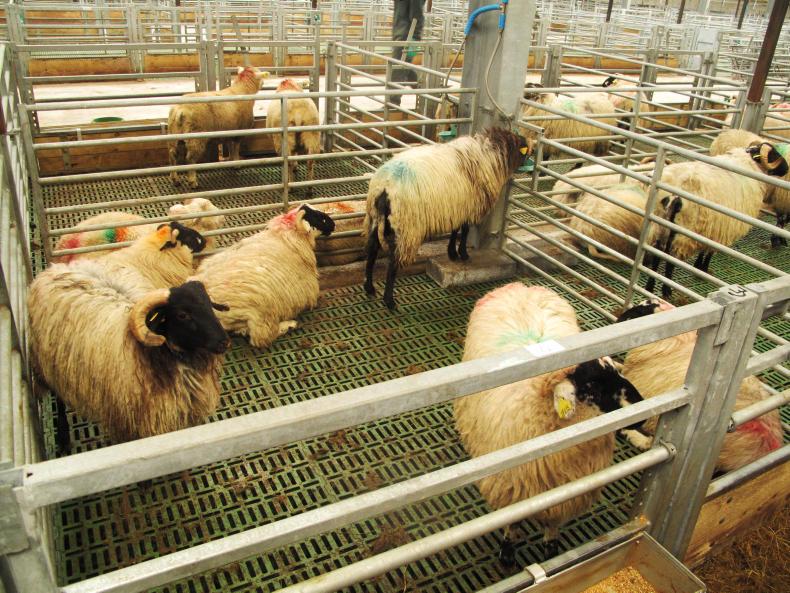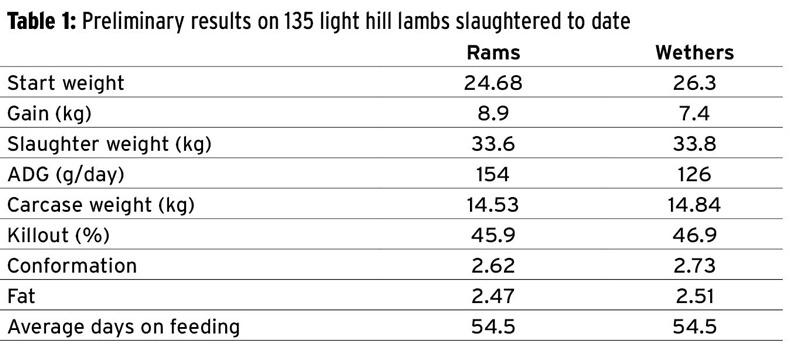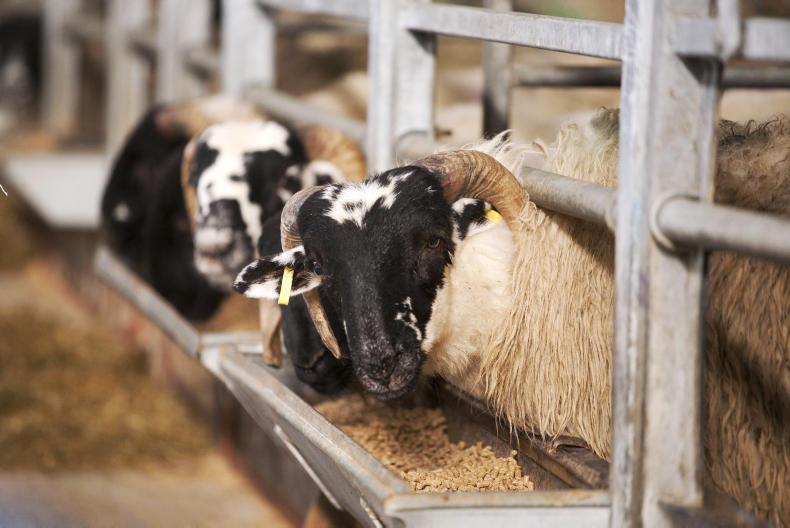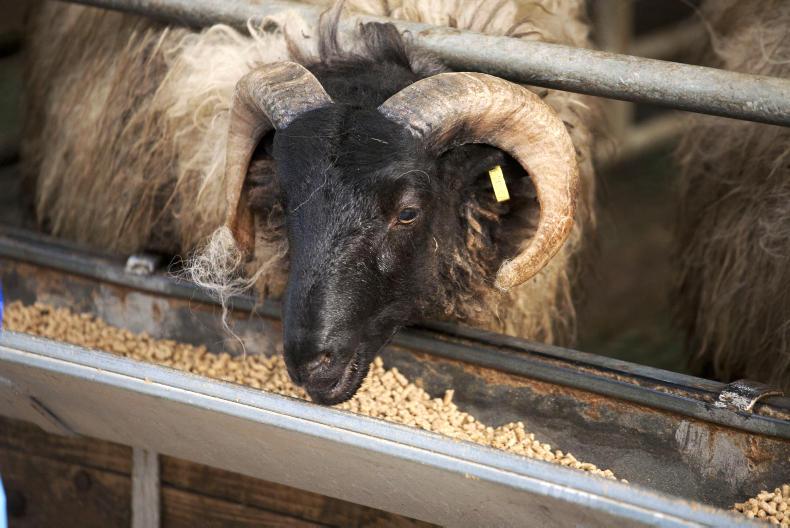Extensive research has been carried out over the last four years in determining profitable routes for finishing hill lambs.
One area highlighted as a missing piece of the jigsaw is finishing routes for light hill lambs. Teagasc set out to address this by purchasing 251 lambs in August, ranging in weight from 20kg to 29kg liveweight.

Lambs were mixed 50:50 on rams and wethers and grazed for four weeks. Lambs weighing less than 30kg were housed on 12 September, with lambs exceeding 30kg retained on pasture until the end of November.
The housed lambs are being slaughtered at present, with preliminary data from those slaughtered to date presented by sheep enterprise leader Michael Diskin at Friday’s Teagasc stakeholder meeting. This data on 135 lambs slaughtered is presented in Table 1.

Lambs were built up to ad lib concentrates once housed and slaughtered after 54.5 days. Wether lambs started at a slightly higher weight and achieved a higher killout, which compensated for a lower daily performance in the region of 30g/day.
Lambs achieved an average carcase weight of 14.53kg and 14.84kg for rams and wethers respectively. The fat cover was positive at an average fat score of 2, with conformation mainly falling into the O grade category.
While there are ongoing challenges in finding a market for light hill lambs, Michael points out that the study proves that a reasonable level of fat cover can be achieved on light hill lambs offered an appropriate high-energy diet.
Michael acknowledges that there is much more scope for heavier lambs to reach French market weights.
Nevertheless, it does provide a blueprint for light hill lambs. The full analysis, along with financial performance, will be detailed when all lambs are slaughtered.
Sheep research gets an added boost
Sheep stakeholders were also given welcome news on the sheep research programme with a number of new trials commencing in the near future.
Teagasc researcher Barbara Good is leading a new project on external parasites, which is very timely given the re-emergence of tick-borne diseases and other issues. Teagasc’s Philip Creighton is also starting a project assessing the role of alternative forages such as chicory, plantain and white and red clover.
These forages are being trialled as part of perennial ryegrass swards, with ewes and lambs grazing these swards in 2018.

As mentioned in the INZAC update on page 40, portable accumulation chambers are being imported from New Zealand and this will allow research to be undertaken on greenhouse gas emissions produced in grass-based sheep production systems.
Meanwhile, Fiona McGovern has been appointed a permanent research position, which strengthens the current research team. Fiona’s post-doctorate position with the INZAC flock will be advertised in the new year.
Besides Fiona’s position Dr Alan Bohan has joined the sheep research programme as a technologist working with Tim Keady on an EU funded project. A total of 4 new Walsh Fellows (Post graduate students) have joined the sheep programme since October. These include John Walsh on alternative forages, Nicola Fetherstone on the INZAC flock, Kyra Hamilton on anthelmintic resistance and Tahir Zahid working on external parasites. This is very welcome news for the sheep industry.
Read more
Potential to finish light hill lambs
Extensive research has been carried out over the last four years in determining profitable routes for finishing hill lambs.
One area highlighted as a missing piece of the jigsaw is finishing routes for light hill lambs. Teagasc set out to address this by purchasing 251 lambs in August, ranging in weight from 20kg to 29kg liveweight.

Lambs were mixed 50:50 on rams and wethers and grazed for four weeks. Lambs weighing less than 30kg were housed on 12 September, with lambs exceeding 30kg retained on pasture until the end of November.
The housed lambs are being slaughtered at present, with preliminary data from those slaughtered to date presented by sheep enterprise leader Michael Diskin at Friday’s Teagasc stakeholder meeting. This data on 135 lambs slaughtered is presented in Table 1.

Lambs were built up to ad lib concentrates once housed and slaughtered after 54.5 days. Wether lambs started at a slightly higher weight and achieved a higher killout, which compensated for a lower daily performance in the region of 30g/day.
Lambs achieved an average carcase weight of 14.53kg and 14.84kg for rams and wethers respectively. The fat cover was positive at an average fat score of 2, with conformation mainly falling into the O grade category.
While there are ongoing challenges in finding a market for light hill lambs, Michael points out that the study proves that a reasonable level of fat cover can be achieved on light hill lambs offered an appropriate high-energy diet.
Michael acknowledges that there is much more scope for heavier lambs to reach French market weights.
Nevertheless, it does provide a blueprint for light hill lambs. The full analysis, along with financial performance, will be detailed when all lambs are slaughtered.
Sheep research gets an added boost
Sheep stakeholders were also given welcome news on the sheep research programme with a number of new trials commencing in the near future.
Teagasc researcher Barbara Good is leading a new project on external parasites, which is very timely given the re-emergence of tick-borne diseases and other issues. Teagasc’s Philip Creighton is also starting a project assessing the role of alternative forages such as chicory, plantain and white and red clover.
These forages are being trialled as part of perennial ryegrass swards, with ewes and lambs grazing these swards in 2018.

As mentioned in the INZAC update on page 40, portable accumulation chambers are being imported from New Zealand and this will allow research to be undertaken on greenhouse gas emissions produced in grass-based sheep production systems.
Meanwhile, Fiona McGovern has been appointed a permanent research position, which strengthens the current research team. Fiona’s post-doctorate position with the INZAC flock will be advertised in the new year.
Besides Fiona’s position Dr Alan Bohan has joined the sheep research programme as a technologist working with Tim Keady on an EU funded project. A total of 4 new Walsh Fellows (Post graduate students) have joined the sheep programme since October. These include John Walsh on alternative forages, Nicola Fetherstone on the INZAC flock, Kyra Hamilton on anthelmintic resistance and Tahir Zahid working on external parasites. This is very welcome news for the sheep industry.
Read more
Potential to finish light hill lambs









 This is a subscriber-only article
This is a subscriber-only article













SHARING OPTIONS: